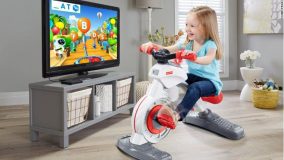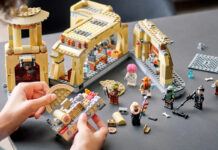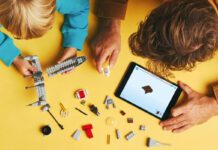 As I write this blog post, both my kids are sitting on the couch glued to their tablets. One is watching some YouTube kids (who likely make more money in a month unboxing toys on camera than I do as a writer in a year), while my daughter is running through the entire run of Gilmore Girls on Netflix. Like many modern parents, I worry about the amount of time they spend on their screens, because nothing beats some healthy exercise for both a growing mind and body.
As I write this blog post, both my kids are sitting on the couch glued to their tablets. One is watching some YouTube kids (who likely make more money in a month unboxing toys on camera than I do as a writer in a year), while my daughter is running through the entire run of Gilmore Girls on Netflix. Like many modern parents, I worry about the amount of time they spend on their screens, because nothing beats some healthy exercise for both a growing mind and body.
Fisher-Price, that name brand you remember from every childhood toy growing up, aims to solve the problem of getting screen-addicted kids to get a little exercise with the introduction of the Think & Learn Cycle, announced at CES 2017 in Las Vegas.
The Fisher-Price Think & Learn Cycle
The Fisher-Price Think & Learn Cycle is a smart device and toy bike that works with a companion app, so toddlers can play educational games while cycling on a stationary bike. Fisher-Price manufactured a similar toy bike in the past, however that one was paired with a television screen and needed game cartridges. The Think & Learn Cycle pairs with the ever-popular tablets, and parents can download the free Android or iOS app that offers different games which teach math, literacy and science or technology skills. Alternately, parents can still pair the cycle to a big screen TV via Bluetooth.
Controlling the Pace of Learning

To control the games/learning experiences, children simply pedal forward or backward, and use the sturdy handlebars to steer. Some games, for instance, teach the alphabet by having kids pick up letters along a route, spelling out and teaching words. Fisher-Price has also apparently partnered with folks like kid-show producer Nickelodeon to create additional games parents can buy after the cycle’s launch in June 2017. So, expect to see games and apps featuring kid favourites like Dora and Spongebob. Game play in the apps can be saved so kids can go back later and resume an activity. And, parents can also monitor their children’s progress in the apps via a dedicated dashboard in each app.
Kids can customize their cycling fun by choosing from a variety of animal characters and vehicles they will see themselves driving on the screen. They can unlock new characters and cars/bikes by playing the games, and advancing through the different levels of learning. The cycle is aimed at kids aged three to six, and it is also adjustable, so it can grow right alongside the body and inquisitive mind of your child.
Hey, I’m an avid mountain biker, so although I would rather my kids just put their darn screens down and go outside and play like I did as a kid; I also understand that times change, and sometimes you have to do what you can as a parent to encourage your wee ones to leave the tech alone and get some exercise. Childhood obesity is a huge problem, and anything that gets kids interested in any physical activity early seems to be a good idea to me. So, the Fisher-Price Think & Learn Cycle appears to be a great way to give your toddler some screen time, while also putting a focus on keeping both their minds and bodies active. Let me know what your thoughts are on the new product in the comments section below.




I completely agree Stevens assessment of this fantastic new toy/learning system. It needs to be underscored (as you pointed out) its not either/or but rather both/and! A child can use a SmartCycle at night, on rainy or cold days when they can’t be outside. There is another limitation to being outside… a child needs supervision at 3-6! Unless its an ideal situation where Dad, Mom or caretaker can have a watchful eye on their little one from a window and the yard is secured so the toddler can’t toddle off, an adult has to be outside too! this is challenging in a world with so many to do’s but not to say this doesn’t happen when mom and dad can commit to just being with their little guy.
In addition there are profound attributes this system provides that are often over looked. When children are active their brains grow by virtue of Brain Growth Hormones released during activity. This brain growth is ephemeral unless a neuroplastic event (memory developed via nerve path transmission) is leveraged across the new brain growth. This system spurs and solidifies new brain growth. Children are emerged and interacting in a contextual framework…they are in another world loving what they are learning because they control (by their actions) all aspects of the gameified, high-resolution, interactive VR content!
Further, they are learning gross motor skills such as hand-eye coordination, balance, pedaling speed and coordinated steering within a visual field! The content and context has no limitation… a child can pedal through outer space, inner space, over land, through oceans and into fantasy lands.
I want one of these for me!
Comments are closed.